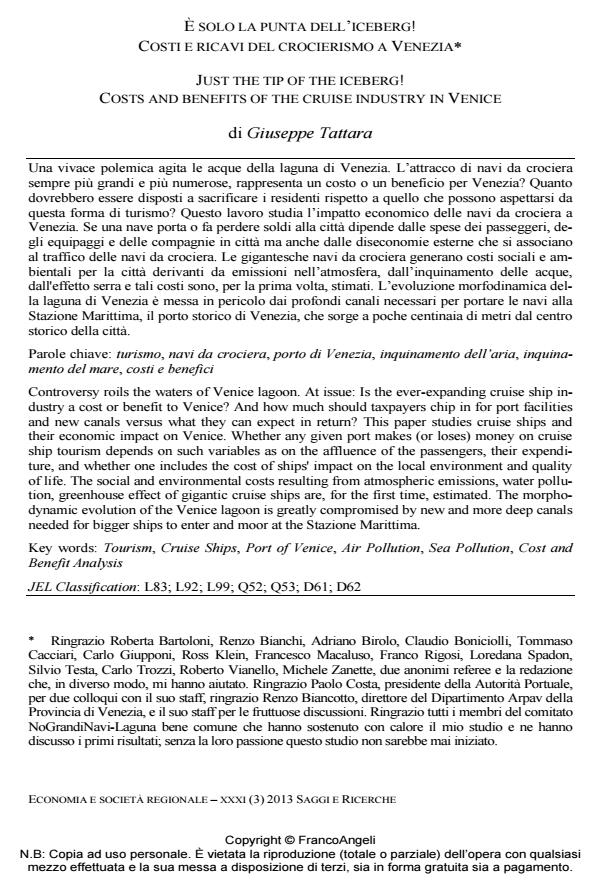Just the tip of the iceberg! Costs and benefits of the cruise industry in venice
Journal title ECONOMIA E SOCIETÀ REGIONALE
Author/s Giuseppe Tattara
Publishing Year 2014 Issue 2013/3
Language Italian Pages 31 P. 136-166 File size 941 KB
DOI 10.3280/ES2013-003013
DOI is like a bar code for intellectual property: to have more infomation
click here
Below, you can see the article first page
If you want to buy this article in PDF format, you can do it, following the instructions to buy download credits

FrancoAngeli is member of Publishers International Linking Association, Inc (PILA), a not-for-profit association which run the CrossRef service enabling links to and from online scholarly content.
Controversy roils the waters of Venice lagoon. At issue: Is the ever-expanding cruise ship industry a cost or benefit to Venice? And how much should taxpayers chip in for port facilities and new canals versus what they can expect in return? This paper studies cruise ships and their economic impact on Venice. Whether any given port makes (or loses) money on cruise ship tourism depends on such variables as on the affluence of the passengers, their expenditure, and whether one includes the cost of ships' impact on the local environment and quality of life. The social and environmental costs resulting from atmospheric emissions, water pollution, greenhouse effect of gigantic cruise ships are, for the first time, estimated. The morphodynamic evolution of the Venice lagoon is greatly compromised by new and more deep canals needed for bigger ships to enter and moor at the Stazione Marittima.
Keywords: Tourism, Cruise Ships, Port of Venice, Air Pollution, Sea Pollution, Cost and Benefit Analysis
Jel codes: L83; L92; L99; Q52; Q53; D61; D62
- Contested port cities: Logistical frictions and civic mobilization in Genoa and Venice Francesca Savoldi, in Environment and Planning C: Politics and Space /2024 pp.1352
DOI: 10.1177/23996544241231684 - Computational Science and Its Applications -- ICCSA 2015 Maria Cerreta, Daniele Cannatella, Giuliano Poli, Sabrina Sposito, pp.50 (ISBN:978-3-319-21409-2)
- Resisting the Tourist Gaze. Art Activism Against Cruise Ship Extractivism in the Venice Lagoon
Emiliano Guaraldo, in Lagoonscapes /2021
DOI: 10.30687/LGSP//2021/01/008
Giuseppe Tattara, È solo la punta dell'iceberg! Costi e ricavi del crocierismo a venezia in "ECONOMIA E SOCIETÀ REGIONALE " 3/2013, pp 136-166, DOI: 10.3280/ES2013-003013